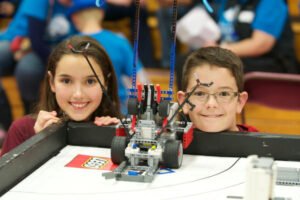Introduction:
Hands-on learning plays a vital role in STEM (Science, Technology, Engineering, and Mathematics) education, providing students with opportunities to engage actively in the learning process, explore concepts through direct experience, and develop essential skills for success in STEM fields and beyond. In this article, we will explore the significance of hands-on learning in STEM education and its impact on student engagement, understanding, and skill development.

Active Engagement:
- Hands-on learning encourages active engagement by allowing students to manipulate materials, conduct experiments, and solve problems in real-world contexts. Through hands-on activities, students become active participants in the learning process, rather than passive recipients of information. This active engagement promotes curiosity, exploration, and inquiry, fostering a deeper understanding of STEM concepts and principles.
Experiential Learning:
- Hands-on learning provides students with experiential learning opportunities that allow them to apply theoretical knowledge to practical situations. By engaging in hands-on activities, students gain firsthand experience with scientific phenomena, engineering challenges, mathematical concepts, and technological tools. This experiential learning approach helps bridge the gap between theory and practice, enabling students to develop a deeper appreciation for STEM disciplines and their real-world applications.
Problem-solving Skills:
- Hands-on learning cultivates problem-solving skills by presenting students with authentic challenges to overcome. Whether designing and building a prototype, conducting an experiment, or troubleshooting a technical problem, students must use critical thinking, creativity, and perseverance to find solutions. Through hands-on activities, students learn to think analytically, collaborate effectively, and adapt to unforeseen obstacles, essential skills for success in STEM careers and everyday life.
Collaboration and Communication:
- Hands-on learning promotes collaboration and communication skills by encouraging students to work together to achieve common goals. Whether collaborating on group projects, sharing ideas during class discussions, or presenting findings to peers, students learn to communicate effectively, listen actively, and respect diverse perspectives. These collaborative experiences foster teamwork, empathy, and leadership skills, preparing students to collaborate with colleagues and communicate ideas effectively in STEM fields and beyond.
Personalized Learning:
- Hands-on learning allows for personalized learning experiences that cater to students’ interests, strengths, and learning styles. By offering a variety of hands-on activities, educators can accommodate diverse learners and provide opportunities for students to explore STEM topics in ways that resonate with their individual preferences and abilities. Whether through experiments, projects, simulations, or field trips, hands-on learning allows students to pursue their passions, develop their talents, and build confidence in their abilities.
Long-term Retention:
- Research has shown that hands-on learning promotes long-term retention of knowledge and skills by engaging multiple senses and neural pathways. By engaging in hands-on activities, students create meaningful connections between concepts, experiences, and outcomes, enhancing their ability to remember and apply what they have learned over time. This long-term retention fosters a deeper understanding of STEM concepts and prepares students for success in higher education, careers, and lifelong learning.
Conclusion:
Hands-on learning is an essential component of STEM education, providing students with opportunities to actively engage in the learning process, apply theoretical knowledge to practical situations, develop critical thinking and problem-solving skills, collaborate effectively with others, personalize their learning experiences, and retain knowledge and skills over the long term. By incorporating hands-on activities into STEM curriculum, educators can inspire curiosity, ignite passion, and empower students to become lifelong learners and innovators in STEM fields and beyond.



